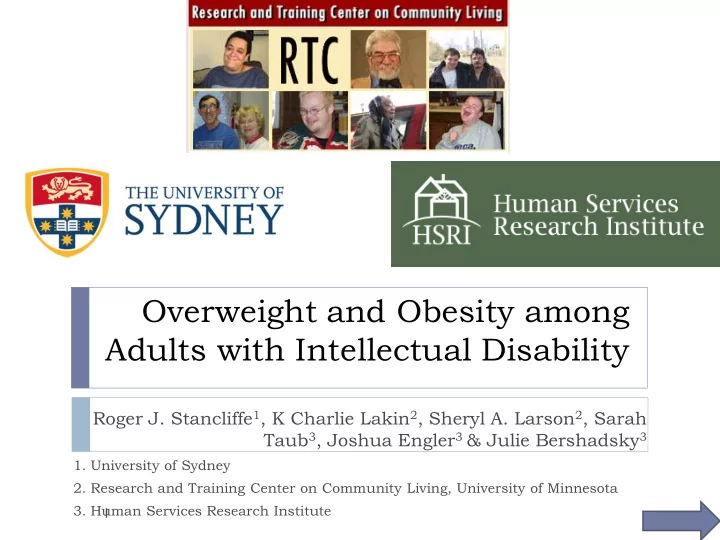

Overweight and Obesity among Adults with Intellectual Disability Roger J. Stancliffe 1 , K Charlie Lakin 2 , Sheryl A. Larson 2 , Sarah Taub 3 , Joshua Engler 3 & Julie Bershadsky 3 1. University of Sydney 2. Research and Training Center on Community Living, University of Minnesota 3. Human Services Research Institute 1
Background Available research suggests that adolescents and adults with intellectual disability have higher prevalence of overweight and obesity than the general community. The present study is the first US study to report BMI- based data for a large (over 8,000) twenty-state sample of adult ID/DD service users with intellectual disabilities. 2
National Core Indicators (NCI) (adult users of state ID/DD services) Collaboration between : National Association of State Directors of Developmental Disabilities Services (NASDDDS) Human Services Research Institute (HSRI). www.nationalcoreindicators.org NCI data gathered annually with a common instrumentation package: Data on weight and height collected for the first time in 2008-09 enabled BMI to be calculated Data collected on a random sample of each state’s service users (minimum 400). 3
BMI Status underweight , BMI < 18.50 normal weight , 18.50 ≤ BMI < 25.00 overweight , 25.00 ≤ BMI < 30.00 obese , BMI ≥ 30.00 Compared 8,911 NCI participants (age 20+) from 20 states with 2007-08 U.S. general population comparison data (age 20+) from: Flegal K.M., Carroll, M.D., & Ogden C.L., & Curtin L.R. (2010). Prevalence and trends in obesity among US adults, 1999-2008. JAMA, 303(3), 235-241. 4
NCI: 20 Participating States 2008-09 MA NY CT WY NJ PA OH DE IN IL MO KY NC SC OK AR AL GA LA TX TX 5
% Overweight and Obese (BMI ≥ 25.0) : Means and 95% CI, US vs NCI 75 70 Percentage of Sample 65 60 55 1 1 1 US all NCI all US men NCI men US women NCI women Group 6
Overweight and Obesity (BMI ≥ 25.0) NCI sample vs. U.S. general population All people NCI (62.2%) significantly less than US (68.0%) Men NCI (60.5%) significantly less than US (72.30%) Women NCI (64.5%) not significantly different from US (64.1%) 7
% Obese (BMI ≥ 30.0) : Means and 95% CI, US vs NCI 45 40 Percentage of Sample 35 30 25 US all NCI all US men NCI men US women NCI women Group 8
Obesity (BMI ≥ 30.0) NCI sample vs. U.S. general population No significant differences in obesity prevalence All people NCI (33.6%) US (33.8%) Men NCI (29.4%) US (32.2%) Women NCI (38.9%) US (35.5%) 9
Obesity (BMI ≥ 30.0) by Level of ID Mild & Moderate > Severe > Profound 100 12.6 90 26.7 38.2 80 41.4 22.8 70 Percentage of Sample 60 29.9 Obese 50 31.3 28.3 Overweight 40 47.8 Normal 30 Underweight 37.9 20 26.7 27.5 10 16.7 5.6 3.7 2.8 0 Mild Moderate Severe Profound Level of ID 10
% Obese by Diagnosis and 95% CI (BMI >=30.0) 50 40 Percentage of Sample 30 20 10 ID only Down Syndrome Autism/PDD Cerebral Palsy Diagnosis 11
% Obesity By Diagnosis Cerebral Intellectual < < < Autism/PDD Down Syndrome Palsy Disability only Adults with Down syndrome had the highest prevalence of obesity and individuals with cerebral palsy had the lowest. 12
% BMI Category by Residence type: All participants 100% 18.6 27.0 31.6 37.7 80% 41.4 Percentage of Participants 42.8 29.0 60% Obese 34.2 Overweight 31.9 24.3 Normal 29.1 26.5 40% Underweight 42.0 32.6 31.4 32.0 20% 27.4 26.2 10.4 6.6 6.2 4.5 3.4 3.3 0% Institution Group Agency Own home Family Foster home apartment home home Residence Type 13
% Obesity by Residence type Host/foster home Family Agency apartment < < < Institution Group home home Own home • Institution residents had the lowest prevalence of obesity and people living in their own home had the highest . • However there were substantial differences in personal characteristics, such as level of intellectual disability, between living arrangements. 14
% BMI Category by Residence Type: Mild ID only 100% 31.4 36.9 39.1 39.1 80% Percentage of Participants 45.9 47.4 60% Obese Overweight 37.7 25.7 Normal 34.9 31.1 27 40% Underweight 25.3 20% 31.0 27.0 27.4 25.2 26.8 25.3 4.2 3.8 2.4 1.8 2.1 1.3 0% Institution Group home Agency Own home Family Foster apartment home home Residence Type 15
% Obesity by Residence Type: Mild ID only Agency apartment Institution < Own home Group home < Own home Family home • Although differences between living arrangements in obesity prevalence remain, the differences are much smaller when level of intellectual disability is controlled. • For example, among people with severe ID there were no significant differences between living arrangements in obesity prevalence. 16
Conclusions Overweight and obesity are serious health issues for American adults with and without ID. Adults with ID mostly did not differ from the general US adult population in prevalence of obesity . For overweight and obesity combined fewer adults with ID were affected than the general population There was a higher prevalence of obesity among women with ID than among men with ID. Level of ID was strongly related to obesity prevalence; individuals with milder ID were more likely to be obese. 17
Conclusions Obesity prevalence differed by living arrangement, with institution residents having the lowest prevalence and people living in their own home the highest. When level of ID was taken into account, these differences between living arrangements were reduced, but some remained significant especially for individuals with milder disability. 18
Conclusions We have shown elsewhere that smaller, less regulated settings, such as living in one’s own home, are consistently associated with desirable outcomes: greater wellbeing greater choice less loneliness whereas institutions are associated with poorer outcomes. Finding effective ways for people to maintain a healthy weight while living in community settings of their choice presents a challenge for all Americans, both those with and without ID. 19
Contact Details Roger J. Stancliffe roger.stancliffe@sydney.edu.au http://sydney.edu.au/health_sciences/ K. Charlie Lakin lakin001@umn.edu http://rtc.umn.edu/main/ Sarah Taub staub@hsri.org http://www.hsri.org/ 20
Recommend
More recommend